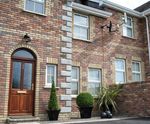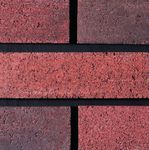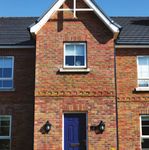Future Shaping New Facing Brick Range 2018/2019 - Lagan Products
←
→
Page content transcription
If your browser does not render page correctly, please read the page content below
Earlswood AG Collection
Collection The colours and textures
from AG’s Heritage, Lanyon
The Earlswood Collection
and Stately ranges ensure
comprises a frogged brick,
that we can offer a brick to
available in a diverse range
suit aesthetics from the hand
of natural colours. The bricks
crafted look of the Heritage
have sharp arrises and a
to the tumbled reclaimed
‘wire-cut’ textured finish.
Lanyon style as well as the
lightly glazed or deep coral
textured finishes available
from the Stately range.
Earlswood Collection: Earlswood Collection: Earlswood Collection: AG Collection: AG Collection: AG Collection:
Antique Terracotta Harvest Blend Antique Autumn Barkley Manor Fergustie Mixture Blanchardstown Antique
Legacy Collection
The rich palette of colours in
the Legacy Collection have
been developed to replicate
the brick tones seen in the
historic districts of our
towns and cities.
AG Collection:
Cedarwood Buff
AG Collection:
Oranmore
Legacy Collection: Legacy Collection:
Clarendon Red Clifton RubyMORTAR MIXES HANDLING
Mortar must be carefully gauged in the proportions given in Depending on the style of brick bond, mortar will account Bricks should be stored on sound, level ground, raised clear of
the specification or obtained from the Architect. Too strong for 17% - 24% of a finish face area of brickwork. Its effect, wet and muddy areas to prevent contamination and staining.
a mix may lead to cracking in the finished work. Too weak a therefore, cannot be under-estimated. Storage areas should be sited close to the points of work to
mix will adversely affect both the strength and durability of reduce unnecessary handling and to minimise damage and
the work. If the sand is dry or saturated the specified A Designation (iv) mortar mix (1:1:6) (Cement: Lime: Sand) waste. Bricks should be protected from the weather on site
volume should be used. If it is damp, it may be necessary or plasticised cement: Sand (1:5-6) is generally recommended
and during construction including the covering of completed
to increase the volume to allow for the effects of bulking. for the construction of most brickwork above D.P.C.
or uncapped brickwork. Waterproof coverings should allow air
In both instances care must be taken to ensure correct
volumes of cement. The mortar should be mixed by hand or machine, in circulation. Materials used in conjunction with facing bricks
accordance with BS 8000: Part 3: 1989, until it has a should also be stored under protection. These precautions
uniform colour throughout. N.B. Shovel mixing of mortar will reduce the likelihood of subsequent lime blooming and
can cause apparent colour changes in areas of brickwork. shrinkage movement.
Damage and wastage will be minimised by mechanical methods
of distribution to points of work. Facing bricks should be lifted
and placed not thrown and tipped. Cleaning Before using
proprietary cleaner please consult us for the best method
of cleaning dirty brickwork. Where proprietary cleaners are
specified, they should be used sparingly and immediately
MOVEMENT CONTROL washed off with clean water, otherwise acid attack could ensue.
HEALTH & SAFETY
GOOD SITE PRACTICE
Bricks should be protected from the weather on site and Care must be taken when handling / working with
All brickwork is subject to movement mainly as a result of c. Ensure that bed joints and perpendicular joints are during construction including the covering of completed but individual products to avoid risk of injury from manual
temperature and atmospheric changes. The following basic fully filled to help prevent rain penetration. handling, sharp edges, abrasive textures and dust
uncapped work. These precautions will reduce the likelihood
recommendations will help accommodate expansion and d. Cavities and wall ties must be clean and free from
of efflorescence and subsequent lime blooming. Care should fragments. Inhalation of any dust produced from
contraction. mortar and debris. The wall-ties should, be laid falling
be taken to prevent mortar smearing the surface of the brick, aggregates must be avoided. Protective clothing
towards the outer leaf – never falling towards the
A Where design considerations preclude discrete panels, inner leaf. The drip of the wall-tie (drip down) must as cleaning at a later stage could be difficult and can lead to must be worn and is activity dependant. Further
incorporate movement control joints to form the brickwork be positioned centrally in the cavity. expensive and time consuming remedial treatments. Prevention information may be obtained by contacting HSENI.
into panels in which the length is not greater than twice e. Partial cavity fill under the provisions of the building is better than cure. All mortar joints should be well filled to help
the height. As a general rule vertical movement joints regulations a 50mm clear cavity must be maintained. prevent weeping. Cavities must be kept clean, as dirty cavities SITE INFORMATION – PACKAGING
to accommodate horizontal movement should be Where partial or full cavity insulation is proposed always increase the risk of water reaching the inner leaf and can Acheson and Glover
provided at typically 6m intervals as per BS 5628: follow the manufacturers recommendations. Fill cavities cause cold bridging.
Part 3 1985 Section Three. Our Sales Department below ground level with concrete to 150mm minimum Heritage Brick
will be pleased to offer advice. and preferably 225mm below the ground level d.p.c. in Bricks should be stored on sound, level ground raised clear of Average Weight of Pack: 1.25 tonne
B Generally do not exceed designation III mortar. If special the outer leaf. This is to stabilise the two leaves and to Number of Bricks per Pack: 448 No.
wet and muddy areas to prevent contamination and staining.
constructions require stronger mortar, reduce the distance prevent the bottom of the wall filling with water.
between movement control joints. Lime Sand Mortar will f. Failure to lap d.p.c. reduces its efficiency.
Storage areas should be sited close to the points of work to Lanyon Brick
help repair small incidence of movement by “self healing”. Recommended minimum lap in d.p.c. 150mm.
The use of Lime Sand Mortar gives a stronger bond than g. Clear weep holes should be provided wherever reduce unnecessary handling and minimise damage and waste. Average Weight of Pack: 1.63 tonne
can be obtained with air entrained mortars of a similar there is extensive bridging of the cavity. Scaffolding boards should be turned back to avoid unsightly Number of Bricks per Pack: 520 No.
compressive strength. This better bond is likely to result h. Propping and strutting of newly erected work, splashing of the work. For protection of finished brickwork:
in greater resistance to rain penetration and improved particularly gable ends, may be necessary during high We advise against using flush copings, use sadleback/half Stately Brick
flexural strength. winds. Scaffolding boards should be turned back to round copings, which incorporates a drip. Average Weight of Pack: 1.63 tonne
C Provide movement control joints where adjoining areas avoid unsightly splashing of the facing work. Finished Number of Bricks per Pack: 512 No
of structure will operate differently i.e. changes in thickness areas of wall should be covered as the work proceeds Design the roof with an overhang. Do not lay Brick when the
and height of wall. to avoid splashing and staining from otherworks. temperature is at or below 3ºC or when freezing may occur Acheson & Glover Brick bales are covered
i. Pre-formed cavity trays with stop ends are recommended. with a polythene hood and strapped, offering
before the mortar has hardened (remember to consider air
We recommend bricks should be used from at least three Trays without stop ends allow water-throw and subsequent
and wind temperature). maximum protection during transportation
bales to ensure a blend throughout the wall and staining of the brick work.
and storage prior to use.
eliminate unsightly banding. j. Sills and copings should project and provide a suitable
drip. Failure to do so throws water onto the face causing
a. Do not lay bricks when temperature is at or below staining and / or lime bloom. Colinwell
3°C, or when freezing may occur before the mortar k. Newly built brick work should be cleaned down and Legacy Collection
has hardened. Consideration should be given to air protected at the end of the working day from rain and Average Weight of Pack: 1.32 tonne
and wind temperature. frost. (Data continued overleaf) Number of Bricks per Pack: 480 No.
b. When building brick in dry / warm conditions ,the
workability of the mortar should be increased rather Earlswood Collection
than wetting the actual brick. In damp weather Average Weight of Pack: 1.05 tonne
conditions, a dryer mortar consistency should be Number of Bricks per Pack: 384 No.
used to help increase suction on the brick.
PACKING: Steel banded packs, shrink
wrapped to non-returnable pallets.For more product information including technical documents, please visit www.laganproducts.com T: 028 92647100 sales@laganproducts.com www.laganproducts.com Part of Breedon Group
You can also read



























































